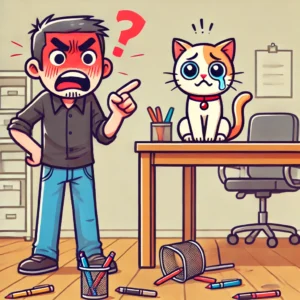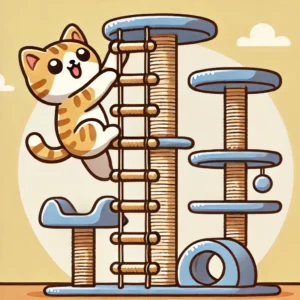Why Do Cats Knock Things Over?
The Truth Behind This Mischievous Act
Crash! There goes another mug, knocked off the counter by your feline friend.
If you’re a cat owner, this scene probably plays out in your home more often than you’d like.
Our furry companions have a knack for turning shelves and tabletops into their dropping zones.
But what’s behind this playful behavior? Is it just cats being cats, or is there something more going on?
Key Takeaways:
|
The Truth Behind Your Cat's Knocking Habit
 1. Hunting Instincts at Play
1. Hunting Instincts at Play
Your cat may look cute and cuddly, but they’re still a hunter deep down. When they bat at objects, they’re practicing their hunting skills. Is that pen rolling off the desk? It could be a scurrying mouse in your cat’s mind.
2. Curiosity Killed the Vase?
Cats are naturally curious creatures. They learn about their environment by touching, smelling, and sometimes knocking things over. It’s their way of saying, “Hey, what’s this thing?”
3. Attention-Seeking Behavior
Let’s face it – when your cat sends something crashing to the floor, you come running. Whether you’re scolding them or just cleaning up, they’ve successfully gotten your attention. For some cats, any attention is good attention.
4. Learning Through Play
Cats learn about their environment through play and exploration. When they knock objects off surfaces, they’re not consciously testing gravity but learning about cause and effect. This behavior helps them understand how objects move and respond to their actions. It’s a form of play that satisfies their curiosity and helps them interact with their surroundings.
5. Boredom Buster
Sometimes, knocking things over is simply a way to beat boredom. If your cat doesn’t have enough mental and physical stimulation, they might create their entertainment at the expense of your belongings.
6. The Joy of Mischief
Let’s be honest – sometimes cats are just plain naughty. They might knock things over simply because it’s fun or because they enjoy the reaction it gets. That little glint in their eye as they slowly push your favorite mug off the table? That’s pure feline mischief at work. It’s not malicious; it’s just cats being cats, finding amusement in ways we might not always appreciate.
7. The Allure of the Unreachable
Cats are naturally curious about the contents of containers, cups, or anything else that might be hiding something interesting. Their paws aren’t designed for careful manipulation, so they often knock things over in their attempt to investigate.
Imagine your cat spotting a half-full glass of water on the coffee table. They’re intrigued by the liquid inside, maybe seeing reflections or movement that catch their eye. As they try to reach in to touch the water or fish out an imaginary treat, their paw catches the rim, and over goes the glass.
This behavior combines their curiosity with their physical limitations. They’re not intentionally trying to spill things, but rather, attempting to explore in the only way they know how. It’s like they’re saying, “What’s in here? Let me just… oops!”
8. Accidental Knockovers
Cats are agile, but they’re not always graceful. Their curious nature and love for exploring tight spaces can lead to unintended consequences. Here’s why accidental knock overs happen:
- Tight Fits: Cats love to squeeze into small spaces or walk along narrow paths, such as shelves or windowsills. In doing so, they might bump into objects without meaning to.
- Tail Swishes: A cat’s long tail can sweep objects off surfaces, especially when excited or focused on something else.
- Misjudged Jumps: When leaping onto or between surfaces, cats might misjudge distances or their size, causing items to fall.
- Poor Depth Perception: Up close, cats don’t see as clearly as humans. They might misjudge the edge of a surface or the position of an object.
This kind of accidental knocking-over is indeed unintentional. It’s simply a byproduct of cats being cats – curious, adventurous, and sometimes a bit clumsy in human-designed spaces.
9. Health Issues – When Knocking Things Over Signals Something More
While this behavior is often playful or instinctual, it’s important to consider health-related causes—especially if the habit is new or unusually frequent.
Certain medical conditions can influence a cat’s behavior, including:
- Cognitive Dysfunction Syndrome (CDS): Older cats with CDS may experience confusion or disorientation, leading them to interact with their environment differently.
- Hyperthyroidism: This condition can cause hyperactivity or restlessness, making cats more likely to swat or knock things over.
- Arthritis: Pain or stiffness might make it harder for cats to move gracefully, leading to accidental bumps and spills.
- Vision Problems: Declining eyesight can result in misjudging distances, causing cats to unintentionally knock things over.
- Neurological Disorders or Anxiety: Issues like seizures or heightened anxiety could trigger changes in how your cat interacts with their surroundings.
If health issues are suspected, the behavior might not just be mischievous—it could be your cat’s way of signaling discomfort.
Managing Your Cat's Knocking Behavior
What NOT to Do
 Before we look into solutions, it’s crucial to understand what you should avoid:
Before we look into solutions, it’s crucial to understand what you should avoid:
Don’t punish your cat. Yelling, spraying water, or physically disciplining your cat won’t solve the problem. It can make things worse by creating fear and anxiety, potentially leading to more problematic behaviors.
Remember, your cat isn’t knocking stuff over out of spite or to annoy you. They’re just following their instincts.
Also, avoid inconsistency. If you laugh when your cat knocks over a pen but scold them for pushing off a glass, you’re sending mixed signals that will confuse your feline friend.
What to Do:
Now that we know what to avoid, here’s what you can do to address this behavior:
- Stimulate Their Senses
Provide Alternative Stimulation Give your cat appropriate outlets for their energy and curiosity. Interactive toys, puzzle feeders, and regular play sessions can keep them entertained and less likely to seek out mischief. - Create a Cat-Friendly Environment
Cat-Proof Your Space Secure valuable or fragile items by placing them in areas your cat can’t reach. Use museum putty for decorative objects you want to display safely. Create designated cat-friendly zones filled with objects they can interact with freely. - Encourage Good Behavior
Use Positive Reinforcement. Reward your cat when it plays with appropriate toys or leaves items alone. If you catch it about to knock something over, gently redirect its attention to a toy or scratching post. - Enrich Your Cat Environment

Give your cats the high ground. Cats are natural climbers who love surveying their domain from high vantage points.
Catering to this instinct can significantly reduce their tendency to explore (and knock things off) your furniture and shelves.
Here’s how:
Install cat trees: Provide tall, sturdy cat trees with multiple levels. These give your cat a designated space to climb, scratch, and perch.
Set up wall shelves: Create a cat superhighway with wall-mounted shelves at various heights. This allows your cat to traverse the room without touching the ground.
Add window perches: Give your cat a sunny spot to watch the world go by. Window beds or perches satisfy their love of heights and provide entertainment.
Use vertical space: Utilize the vertical space in your home with climbing poles, hanging beds, or even repurposed bookcases designed for cat use.
By providing these cat-friendly vertical spaces, you’re giving your feline friend appropriate places to fulfill their climbing instincts.
This can significantly reduce their inclination to jump on your tables and shelves, minimizing the chance of them knocking things over.
Remember to place cat-safe toys or comfortable bedding on these high spots to make them even more appealing to your cat.
5. Address the Root Cause
Address Underlying Issues Ensure your cat is healthy and well-fed. Consider any potential stress factors in their environment that might be contributing to the behavior.
6. Stay on Track
Be Consistent Maintain a routine and ensure all family members follow the same rules regarding cat behavior.
7. Know When to Ask for Help.
Know When to Seek Help If the behavior persists or worsens, consult with your veterinarian or a cat behaviorist. They can provide personalized advice and rule out any underlying health issues.
Wrapping Up: Embracing the Chaos
Living with cats means embracing a bit of chaos. Their knocking behavior, while sometimes frustrating, is part of what makes them unique and entertaining companions. By understanding the reasons behind this habit and implementing the strategies we’ve discussed, you can create a harmonious environment that satisfies you and your feline friend.
Remember, patience is vital. Your cat isn’t trying to drive you crazy – they’re just being a cat. With a little effort and much love, you can turn those knocked-over objects into shared moments of play and bonding.
Share your experiences in the comments below! How have you successfully managed your cat’s “knocking-over” behavior? Your insights could help fellow cat lovers find new ways to live harmoniously with their mischievous felines.
If you are interested to learn more about weird cat behaviors, check out this post on “Weird Cat Behaviors Explained-Why Cats Do the Strangest Things?”
Related articles:
Why Do Cats Headbutt? – Decoding the Irresistible Charm
Why is my cat licking the floor? Bizarre or Normal?
Cat Zoomies Explained: Why Do Cats Suddenly Turn Into Cheetahs?
Cat ‘Making Biscuits’: The Quirky Reasons Behind Your Cat’s Kneading Habit
8 Hidden Reasons Why Your Cat Covers Their Food (Some May Surprise You!)
Fascinating Yet Creepy: Why Cats Stare at Empty Spaces?
7 Secret Reasons Why Cats Lift Their Bum When Petted – And It Will Melt Your Heart!
Why Cats Chew on Plastic: Unraveling This Bizarre Behavior
Why Do Cats Bring You ‘Gifts’? Unraveling the Mystery of Cat “Gift-Giving” Behavior
The Art of Cat Napping: Why Cats Sleep in the Strangest Places in the Funniest Positions
Cats and Boxes: Unlocking the Secrets Behind This Irresistible Obsession
The Secrets Behind Your Cat’s Bird-Watching Chirps and Chatters
Please share this article if you think it deserves. Have a nice day!
